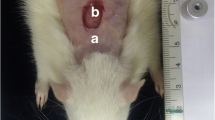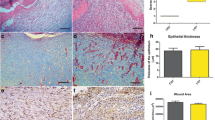Abstract
Epidermal growth factor (EGF) and light-emitting diode (LED) are currently deployed as promissory treatments for skin repair; however, the mechanisms of their association are not yet evidenced. Thus, the present study aimed to evaluate the effects of combined treatment with EGF and red LED on the wound healing processes in rats. Adult Wistar rats were randomized in control group (CG) wounds without treatment; wounds submitted to EGF treatment (EGF); wounds submitted to LED treatment (LED); wounds submitted to EGF associated with LED treatments (EGF/LED). Treatments were performed immediately after the surgical procedure and each 24 h, totaling 8 sessions. Moreover, LED was applied before EGF treatment at a single point in the center of the wound. Morphological characteristics and the immunoexpression of COX-2, VEGF, and TGF-β were measured. The results demonstrated that EGF/LED group presented a higher wound healing index. Additionally, all experimental groups presented similar findings in the histological evaluation, the degree of inflammation, and the area of dermis-like tissue. However, for EGF-treated animals (with or without LED), neoepithelial length was higher. Furthermore, all the treated groups decreased COX-2 and increased VEGF immunoexpression, and only EGF/LED group enhanced the TGF-β protein expression when compared to the untreated group. This research shows that EGF and LED modulate inflammatory process and increase the vascularity. In addition, treatment of EGF associated with LED promoted a more evident positive effect for increasing TGF-β expression and may be promising resources in the clinical treatment of cutaneous wounds.









Similar content being viewed by others
Data availability
CEUA no 3390150419 (ID 008535).
References
Rezaie F, Momeni-Moghaddam M, Naderi-Meshkin H (2019) Regeneration and repair of skin wounds: various strategies for treatment. Int J Low Extrem Wounds 18(3):247–261. https://doi.org/10.1177/1534734619859214
Borena BM, Martens A, Broeckx SY, Meyer E, Chiers K, Duchateau L, Spaas JH (2015) Regenerative skin wound healing in mammals: state-of-the-art on growth factor and stem cell based treatments. Cell Physiol Biochem 36(1):1–23. https://doi.org/10.1159/000374049
Gurtner GC, Werner S, Barrandon Y, Longaker MT (2008) Wound repair and regeneration. Nature 453(7193):314–321. https://doi.org/10.1038/nature07039
Demidova-Rice TN, Hamblin MR, Herman IM (2012) Acute and impaired wound healing: pathophysiology and current methods for drug delivery, part 1: normal and chronic wounds: biology, causes, and approaches to care. Adv Skin Wound Care 25(7):304–314. https://doi.org/10.1097/01.ASW.0000416006.55218.d0
Childs DR, Murthy AS (2017) Overview of wound healing and management. Surg Clin North Am 97(1):189–207. https://doi.org/10.1016/j.suc.2016.08.013
Bowers S, Franco E (2020) Chronic wounds: evaluation and management. Am Fam Physician 101(3):159–166
Jagdeo J, Austin E, Mamalis A, Wong C, Ho D, Siegel DM (2018) Light-emitting diodes in dermatology: a systematic review of randomized controlled trials [published online ahead of print. Lasers Surg Med 50(6):613–628. https://doi.org/10.1002/lsm.22791
Heiskanen V, Hamblin MR (2018) Photobiomodulation: lasers vs. light emitting diodes? Photochem Photobiol Sci 17(8):1003–1017. https://doi.org/10.1039/c8pp90049c
Sorbellini E, Rucco M, Rinaldi F (2018) Photodynamic and photobiological effects of light-emitting diode (LED) therapy in dermatological disease: an update. Lasers Med Sci 33(7):1431–1439. https://doi.org/10.1007/s10103-018-2584-8
de Sousa AP, Santos JN, Dos Reis Jr JA, Ramos TA, de Souza J, Cangussú MC, Pinheiro (2010) Effect of LED phototherapy of three distinct wavelengths on fibroblasts on wound healing: a histological study in a rodent model. Photomed Laser Surg 28(4):547–52. https://doi.org/10.1089/pho.2009.2605
Simões T, FernandesNeto JA, de Oliveira T, Nonaka C, Catão M (2020) Photobiomodulation of red and green lights in the repair process of third-degree skin burns. Lasers Med Sci 35(1):51–61. https://doi.org/10.1007/s10103-019-02776-7
Mosca RC, Ong AA, Albasha O, Bass K, Arany P (2019) Photobiomodulation therapy for wound care: a potent, noninvasive, photoceutical approach. Adv Skin Wound Care 32(4):157–167. https://doi.org/10.1097/01.ASW.0000553600.97572.d2
Huang YY, Sharma SK, Carroll J, Hamblin MR (2011) Biphasic dose response in low level light therapy - an update. Dose-Response 9(4):602–618. https://doi.org/10.2203/dose-response.11-009.Hamblin
Kim WS, Calderhead RG (2011) Is light-emitting diode phototherapy (LED-LLLT) really effective? Laser Ther 20(3):205–15. https://doi.org/10.5978/islsm.20.205
Kerppers II, de Lima CJ, Fernandes AB, Villaverde AB (2015) Effect of light-emitting diode (ʎ 627 nm and 945 nm ʎ) treatment on first intention healing: immunohistochemical analysis. Lasers Med Sci 30(1):397–401. https://doi.org/10.1007/s10103-014-1668-3
Martignago CCS, Tim CR, Assis L, Da Silva VR, SantosE Vieira FN, Parizotto NA, Liebano RE (2020) Effects of red and near-infrared LED light therapy on full-thickness skin graft in rats. Lasers Med Sci 35(1):157–164. https://doi.org/10.1007/s10103-019-02812-6
Boyko TV, Longaker MT, Yang GP (2018) Review of the current management of pressure ulcers. Adv Wound Care (New Rochelle) 7(2):57–67. https://doi.org/10.1089/wound.2016.0697
Esquirol-Caussa J, Herrero-Vila E (2019) Human recombinant epidermal growth factor in skin lesions: 77 cases in EPItelizando project. J Dermatolog Treat 30(1):96–101. https://doi.org/10.1080/09546634.2018.1468546
Bui TQ, Bui Q, Németh D, Hegyi P, Szakács Z, Rumbus Z, Tóth B, Emri G, Párniczky A, Sarlós P, Varga O (2019) Epidermal growth factor is effective in the treatment of diabetic foot ulcers: meta-analysis and systematic review. Int J Environ Res Public Health 16(14):2584. https://doi.org/10.3390/ijerph16142584
Berlanga-Acosta J, Gavilondo-Cowley J, López-Saura P, González-López T, Castro-Santana MD, López-Mola E, Guillén-Nieto G, Herrera-Martinez L (2009) Epidermal growth factor in clinical practice - a review of its biological actions, clinical indications and safety implications. Int Wound J 6(5):331–346. https://doi.org/10.1111/j.1742-481X.2009.00622
Kim YS, Lew DH, Tark KC, Rah DK, Hong JP (2010) Effect of recombinant human epidermal growth factor against cutaneous scar formation in murine full-thickness wound healing. J Korean Med Sci 25(4):589–596. https://doi.org/10.3346/jkms.2010.25.4.589
Park JW, Hwang SR, Yoon IS (2017) Advanced growth factor delivery systems in wound management and skin regeneration. Molecules 22(8):1259. https://doi.org/10.3390/molecules22081259
Otterço AN, Andrade AL, Brassolatti P, Pinto KNZ, Araújo HSS, Parizotto NA (2018) Photobiomodulation mechanisms in the kinetics of the wound healing process in rats. J Photochem Photobiol B Biol 183:22–29. https://doi.org/10.1016/j.jphotobiol.2018.04.010
Jinno C, Morimoto N, Ito R, Sakamoto M, Ogino S, Taira T, Suzuki S (2016) A Comparison of conventional collagen sponge and collagen-gelatin sponge in wound healing. Biomed Res Int 2016.https://doi.org/10.1155/2016/4567146
Uzêda-e-Silva VD, Rodriguez T, Rocha IAR, Xavier FCA, dos Santos JN, Cury PR, Ramalho LMP (2016) Laser phototherapy improves early stage of cutaneous wound healing of rats under hyperlipidic diet. Lasers Med Sci 31(7):1363–1370
Paraguassú GM, Guarda MG, Xavier FC, Cangussu MC, Rodriguez TT, Ramalho MJ, Pinheiro AL, Ramalho LM (2014) Effects of LED phototherapy on relative wound contraction and reepithelialization during tissue repair in hypothyroid rats: morphometric and histological study. Lasers Med Sci 29(2):773–779. https://doi.org/10.1007/s10103-013-1419-x
Xie Z, Paras CB, Weng H, Punnakitikashem P, Su LC, Vu K, Tang L, Yang J, Nguyen KT (2013) Dual growth factor releasing multi-functional nanofibers for wound healing. Acta Biomater 9(12):9351–9359. https://doi.org/10.1016/j.actbio.2013.07.030
Gainza G, Bonafonte DC, Moreno B, Aguirre JJ, Gutierrez FB, Villullas S, Pedraz JL, Igartua M, Hernandez RM (2015) The topical administration of rhEGF-loaded nanostructured lipid carriers (rhEGF-NLC) improves healing in a porcine full-thickness excisional wound model. J Control Release 197:41–47. https://doi.org/10.1016/j.jconrel.2014.10.033
João De Masi EC, Campos AC, João De Masi FD, Ratti MA, Ike IS, De Masi João (2016) The influence of growth factors on skin wound healing in rats. Braz J Otorhinolaryngol 82(5):512–21. https://doi.org/10.1016/j.bjorl.2015.09.011
Choi JK, Jang JH, Jang WH, Kim J, Bae IH, Bae J, Park YH, Kim BJ, Lim KM, Park JW (2012) The effect of epidermal growth factor (EGF) conjugated with low-molecular-weight protamine (LMWP) on wound healing of the skin. Biomaterials 33(33):8579–8590. https://doi.org/10.1016/j.biomaterials.2012.07.061
Buch PR, Desai I, Balakrishnan S (2018) COX-2 activity and expression pattern during regenerative wound healing of tail in lizard Hemidactylus flaviviridis. Prostaglandins Other Lipid Mediat 135:11–15. https://doi.org/10.1016/j.prostaglandins.2018.01.002
Xu M, Wang T, Li W, Wang Y, Xu Y, Mao Z, Wu R, Liu M, Liu Y (2019) PGE2 facilitates tail regeneration via activation of Wnt signaling in Gekko japonicus. J Mol Histol 50(6):551–562. https://doi.org/10.1007/s10735-019-09847-7
Lopes-Martins RAB, Leonardo PS, Bjordal JM, Marcos RL (2020) Photobiomodulation: inhibition or resolution of the inflammatory process? Photobiomodul Photomed Laser Surg 38(8):453–454. https://doi.org/10.1089/photob.2020.4825
Liu LH, Fan X, An YX, Zhang J, Wang CM, Yang RY (2014) Randomized trial of three phototherapy methods for the treatment of acne vulgaris in Chinese patients. Photo- dermatol Photoimmunol Photomed 30(5):246–253. https://doi.org/10.1111/phpp.12098
Silveira PC, Ferreira KB, da Rocha FR, Pieri BL, Pedroso GS, De Souza CT, Nesi RT, Pinho RA (2016) Effect of low-power laser (LPL) and light-emitting diode (LED) on inflammatory response in burn wound healing. Inflammation 39(4):1395–404. https://doi.org/10.1007/s10753-016-0371-x
Park KY, Han TY, Kim IS, Yeo IK, Kim BJ, Kim MN (2013) The effects of 830 nm light-emitting diode therapy on acute herpes zoster ophthalmicus: a pilot study. Ann Dermatol 25(2):163–167. https://doi.org/10.5021/ad.2013.25.2.163
Lutmer J, Watkins D, Chen CL, Velten M, Besner G (2013) Heparin-binding epidermal growth factor-like growth factor attenuates acute lung injury and multiorgan dysfunction after scald burn. J Surg Res 185(1):329–37. https://doi.org/10.1016/j.jss.2013.05.064
Su Y, Luo H, Yang J (2018) Heparin-binding EGF-like growth factor attenuates lung inflammation and injury in a murine model of pulmonary emphysema. Growth Factors. 36(5–6):246–262. https://doi.org/10.1080/08977194.2018.1552270
Kargozar S, Baino F, Hamzehlou S, Hamblin MR, Mozafari M (2020) Nanotechnology for angiogenesis: opportunities and challenges. Chem Soc Rev 49(14):5008–5057. https://doi.org/10.1039/c8cs01021h
Li L, Liu H, Xu C, Deng M, Song M, Yu X, Xu S, Zhao X (2017) VEGF promotes endothelial progenitor cell differentiation and vascular repair through connexin 43. Stem Cell Res Ther 8(1):237. https://doi.org/10.1186/s13287-017-0684-1
de AlencarFernandesNeto J, Nonaka CFW, de VasconcelosCatão MHC (2019) Effect of blue LED on the healing process of third-degree skin burns: clinical and histological evaluation. Lasers Med Sci 34(4):721–728. https://doi.org/10.1007/s10103-018-2647-x
Dungel P, Hartinger J, Chaudary S, Slezak P, Hofmann A, Hausner T, Strassl M, Wintner E, Redl H, Mittermayr R (2014) Low level light therapy by LED of different wavelength induces angiogenesis and improves ischemic wound healing. Lasers Surg Med 46(10):773–80. https://doi.org/10.1002/lsm.22299
Nishioka MA, Pinfildi CE, Sheliga TR, Arias VE, Gomes HC, Ferreira LM (2012) LED (660 nm) and laser (670 nm) use on skin flap viability: angiogenesis and mast cells on transition line. Lasers Med Sci 27(5):1045–1050. https://doi.org/10.1007/s10103-011-1042-7
Parker LH, Schmidt M, Jin SW, Gray AM, Beis D, Pham T, Frantz G, Palmieri S, Hillan K, Stainier DY, De Sauvage FJ, Ye W (2004) The endothelial-cell-derived secreted factor Egfl7 regulates vascular tube formation. Nature 428(6984):754–758. https://doi.org/10.1038/nature02416
Usuba R, Pauty J, Soncin F, Matsunaga YT (2019) EGFL7 regulates sprouting angiogenesis and endothelial integrity in a human blood vessel model. Biomaterials 197:305–316. https://doi.org/10.1016/j.biomaterials.2019.01.022
Penn JW, Grobbelaar AO, Rolfe KJ (2012) The role of the TGF-β family in wound healing, burns and scarring: a review. Int J Burns Trauma 2(1):18–28
Kasuya A, Tokura Y (2014) Attempts to accelerate wound healing. J Dermatol Sci 76(3):169–172. https://doi.org/10.1016/j.jdermsci.2014.11.001
Khanbanha N, Atyabi F, Taheri A, Talaie F, Mahbod M, Dinarvand R (2014) Healing efficacy of an EGF impregnated triple gel based wound dressing: in vitro and in vivo studies. Biomed Res Int 2014:493732. https://doi.org/10.1155/2014/493732
Author information
Authors and Affiliations
Corresponding author
Ethics declarations
Ethical approval
This study was approved by the Ethics Committee on the Use of Animals under number 3390154019 and conducted according to the international norms of ethics on animal experimentation (National Research Council, 1996).
Competing interest
The authors declare no competing interests.
Additional information
Publisher's note
Springer Nature remains neutral with regard to jurisdictional claims in published maps and institutional affiliations.
Rights and permissions
Springer Nature or its licensor (e.g. a society or other partner) holds exclusive rights to this article under a publishing agreement with the author(s) or other rightsholder(s); author self-archiving of the accepted manuscript version of this article is solely governed by the terms of such publishing agreement and applicable law.
About this article
Cite this article
Busanello-Costa, M., Renno, A.C.M., de Goes Santos, C.P. et al. Red LED light therapy associated with epidermal growth factor on wound repair process in rats. Lasers Med Sci 38, 36 (2023). https://doi.org/10.1007/s10103-022-03701-1
Received:
Accepted:
Published:
DOI: https://doi.org/10.1007/s10103-022-03701-1




